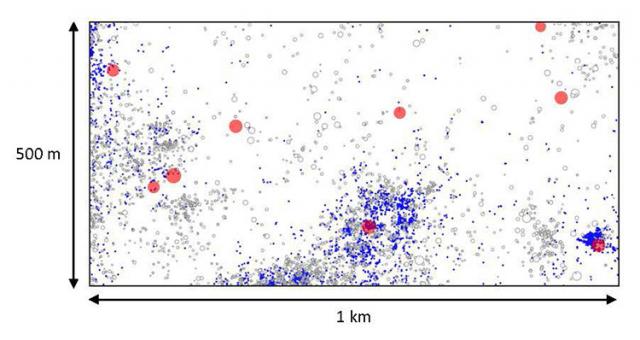Home > Research > Research Results > Research Results 2018 > Bat-dispersed Calophyllum seeds survive in dense clumps
Update:October 9, 2018
Main content starts here.
Bat-dispersed Calophyllum seeds survive in dense clumps
| Article title |
Resolving the paradox of clumped seed dispersal: positive density and distance dependence in a bat-dispersed species |
|---|---|
| Author (affiliation) |
Anna Sugiyama (a), Liza S. Comita (b), Takashi Masaki (c), Richard Condit (d), Stephen P. Hubbell (a) (a) University California, Los Angeles, CA, USA. (c) Research Planning and Coordination Department, FFPRI, Tsukuba, Ibaraki, Japan. (d) Field Museum of Natural History, Chicago, IL, USA. |
| Publication Journal |
Ecology、Ecology Society America、 04 September 2018, DOI:10.1002/ecy.2512( External link ) |
| Content introduction |
When a clump of seeds falls near its maternal tree, it attracts seed predators and fungal pathogens, which can lead to high mortality of the seeds. To avoid this, seeds have evolved to be transported away from the maternal tree by wind or animals (“seed dispersal”). In the case of bat-dispersed seeds in the Central American tropical forests, the bats tend to transport fruits from maternal trees to distant roosts for leisurely feeding and drop their seeds below the roosts. This causes the seeds and seedlings to be densely clumped in a location far away from the maternal trees, which appears to cancel out the benefit of seed dispersal. This is termed as the “paradox of clumped seed dispersal”. We hypothesized that the seeds are more likely to survive even in dense clumps, as long as they are far from maternal trees, and we chose Calophyllum longifolium, a bat-dispersed tree species, as the target of our study. We created a distribution map of all the trees and seedlings within a 50-ha forest research plot in Panama and tracked their survival and growth for 3 years. We found that the distance of the seedling clumps from the maternal trees affected the chance of seedling survival in a positive manner. Depending on the time of investigation, the clumped seedlings grew to be taller than those that were not clumped. Locations beneath bat feeding roosts were more suitable than others for enhanced survival and growth of Calophyllum seedlings, which defies the conventional ecological assumption of seed dispersal. Consequently, it shows that trees and bats have been closely co-evolved in the Central American tropical forests.
|
Copyright © Forest Research and Management Organization. All rights reserved.

